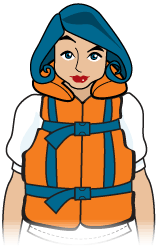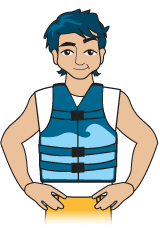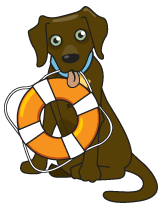| PFD TYPE |
BEST FOR |
DISADVANTAGES |
NOTES |

TYPE I:
OFFSHORE LIFE JACKET
|
All waters, especially open, rough, or remote waters where rescue can be delayed
|
Large and awkward; difficult to swim in
|
Adult size: 22 lb. of buoyancy.
Child size: 11 lb. of buoyancy.
Will turn unconscious wearers to face-up position.
|

TYPE II:
NEAR-SHORE BUOYANT VEST
|
Calm, inland waters where there is a good chance of rescue
|
May not turn some unconscious wearers face-up
|
Adult size: 15 1/2 lb. of buoyancy.
Child size: 11 lb. of buoyancy.
Infant size: 7 lb. of buoyancy.
Will turn some unconscious wearers to face-up position.
|

TYPE III:
FLOTATION AID
|
Calm, inland waters where there is a good chance of rescue
|
Wearers must put themselves in face-up position
|
Same buoyancy as Type II.
examples:
Float coat, fishing vest, water sport vest.
|

TYPE IV:
DEVICE
|
All waters where help is present
|
Not designed to be worn; intended for use in waters with heavy boat traffic
|
Designed to be thrown and grasped until rescued; never worn.
examples:
Cushions, ring buoys, horseshoe buoys
|

TYPE V:
SPECIAL USE DEVICE
|
Specific activities; check approval condition on label |
Some Type Vs are designed for cooler climates and others are approved only when worn |
Some Type V devices provide hypothermia protection.
examples:
Deck suits, work vests, boardsailing vests
|